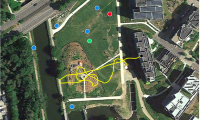Abstract
The effects of changes in various visual and olfactory properties of a white card surface on the landing position of male Epiphyas postvittanaexhibiting pheromone-mediated flight were studied in a wind tunnel. Males landed predominantly at the most downwind position of a surface in line with the pheromone source, regardless of the strength of the source. The position on the surface that males landed was strongly influenced by visual factors. The landing position of males appeared to be influenced by visual cues along all three axes of the surface. Decreases in either the dimension horizontally perpendicular to the wind direction or the vertical dimension resulted in greater numbers of males landing farther upwind on the surface than the downwind edge. Visual changes in the axis along the wind direction also affected the position at which males landed. For example, when presented with two white card surfaces with a 4- cm gap between them, males tended to land on the downwind edge of the upwind surface (on which the source was located). When the gap was bridged with clear Mylar, the landing pattern was significantly different, with the greater proportion of males landing on the downwind surface. However, when Mylar was placed on the plexiglass floor of the tunnel (in addition to bridging the gap), the landing pattern on the surface was not significantly different from that on the two surfaces without the Mylar bridge. It is suggested that during the prelanding and landing phases of pheromone-mediated flight, male moths orient to visual features of the surface containing the pheromone source rather than to visual features of the source (conspecific female moth) itself.
Similar content being viewed by others
References
Baker, T. C. (1989). Pheromones and flight behavior. In Goldsworthy, G. J., and Wheeler, C. H. (eds.),Insect Flight, CRC Press, Boca Raton, FL, pp. 231–255.
Baker, T. C. (1990). Sex pheromone communication in the Lepidoptera: New research progress.Experientia 45: 248–262.
Baker, T. C., and Cardé, R. T. (1978). Disruption of gypsy moth male sex pheromone behavior by high frequency sound.Environ. Entomol. 7: 45–52.
Bell, W. J. (1990). Searching behavior patterns in insects.Annu. Rev. Entomol. 35: 447–467.
Bellas, T. E., Bartell, R. J., and Hill, A. S. (1983). Identification of two components of the sex pheromone of the moth,Epiphyas postvittana (Lepidoptera: Tortricidae).J. Chem. Ecol. 9: 503–512.
Borst, A. (1990). How do flies land? From behavior to neuronal circuits.Bioscience 40: 292–299.
Castrovillo, P. J., and Cardé, R. T. (1980). Male codling moth (Laspeyresia pomonella) orientation to visual cues in the presence of pheromone and sequences of courtship behaviors.Ann. Entomol. Soc. Am. 73: 100–105.
Charlton, R. E., and Cardé, R. T. (1990). Orientation of male gypsy moths,Lymantria dispar (L.), to pheromone sources: The role of olfactory and visual cues.J. Insect. Behav. 3: 443–469.
Coggshall, J. C. (1972). The landing response and visual processing in the milkweed bug,Oncopeltus fasciatus.J. Exp. Biol. 57: 401–413.
Collett, T. S., and King, A. J. (1975). Vision during flight. In Horridge, G. A. (ed.),The Compound Eye and Vision of Insects, Clarendon Press, Oxford, pp. 437–466.
Eckert, H. (1983). On the landing response of the blowfly,Calliphora erythrocephala.Biol. Cybern. 47: 119–130.
Foster, S. P., Muggleston, S. J., and Ball, R. D. (1991). Behavioral responses of maleEpiphyas postvittana (Walker) to sex pheromone-baited delta trap in a wind tunnel.J. Chem. Ecol. 17: 1449–1468.
Goodman, L. J. (1960). The landing response of insects. I. The landing response of the fly,Lucilia sericata and other Calliphorinae.J. Exp. Biol. 37: 854–878.
Kennedy, J. S. (1951). The migration of the desert locust (Scistocerca gregaria Forsk.). I. The behaviour of swarms. II. A theory of long-range migrations.Phil. Trans. Roy. Soc. B 235: 163–290.
Kuenen, L. P. S., and Baker, T. C. (1982). Optomotor regulation of ground velocity in moths during flight to sex pheromone at different heights.Physiol. Entomol. 7: 193–202.
Lundberg, S., and Löfstedt, C. (1987). Intra-specific competition in the sex pheromone communication channel: A selective force in the evolution of moth pheromones?.J. Theor. Biol. 125: 15–24.
Miller, J. R., and Roelofs, W. L. (1978). Sustained-flight tunnel for measuring insect responses to wind-borne sex pheromones.J. Chem. Ecol. 4: 187–198.
Muggleston, S. J., and Foster, S. P. (1989). Sustained-flight tunnel responses of male lightbrown apple moth to synthetic sex pheromone.Physiol. Entomol. 14: 443–449.
Preiss, R. (1987). Motion parallax and figural properties of depth control flight speed in an insect.Biol. Cybern. 57: 1–9.
Preiss, R., and Kramer, E. (1984). Control of groundspeed by minimization of the apparent ground pattern movement. In Varjü, D., and Schnitzler, H.-U. (eds.),Localization and Orientation in Biology and Engineering, Springer, Berlin, pp. 140–142.
Preiss, R., and Kramer, E. (1986). Pheromone-induced anemotaxis in simulated free flight. In Payne, T. L., Birch, M. C., and Kennedy, C. E. J., (eds.),Mechanisms in Insect Olfaction, Clarendon Press, Oxford, pp. 69–79.
Singh, P. (1974). A chemically defined medium for rearingEpiphyas postvittana (Lepidoptera: Tortricidae).N.Z. J. Zool. 1: 241–243.
Wagner, H. (1982). Flow-field variables trigger landing in flies.Nature 297: 147–148.
Wall, C., and Perry, J. N. (1978). Interactions between pheromone traps for the pea moth,Cydia nigricana (F.).Entomol. Exp. Appl. 24: 155–162.
Wall, C., and Perry, J. N. (1980). Effects of spacing and trap number on interactions between pea moth pheromone traps.Entomol. Exp. Appl. 28: 313–321.
Wehner, R. (1972). Spontaneous pattern preferences ofDrosophila melanogaster to black areas in various parts of the visual field.J. Insect Physiol. 18: 1531–1543.
Wehner, R. (1981). Spatial vision in arthropods. In Autrum, H. (ed.),Handbook of Sensory Physiology, Vol. 7/6C, Springer, Berlin, pp. 287-616.
Witzgall, P., and Priesner, E. (1984). Behavioural responses ofColeophora laricella male moths to synthetic sex-attractant, (Z)-5-decenol, in the field.Z. Ang. Ent. 98: 15–33.
Zagatti, P., and Renou, M. (1984). Les phéromones sexualles des zygènes III. Le comportement deZygaena filipendulae L. (Lepidoptera, Zyganidae).Ann. Soc. Entomol. Fr. (N.S.) 4: 439–454.
Author information
Authors and Affiliations
Rights and permissions
About this article
Cite this article
Foster, S.P., Harris, M.O. Factors influencing the landing of maleEpiphyas postvittana (Walker) exhibiting pheromone-mediated flight (Lepidoptera: Tortricidae). J Insect Behav 5, 699–720 (1992). https://doi.org/10.1007/BF01047981
Accepted:
Issue Date:
DOI: https://doi.org/10.1007/BF01047981




